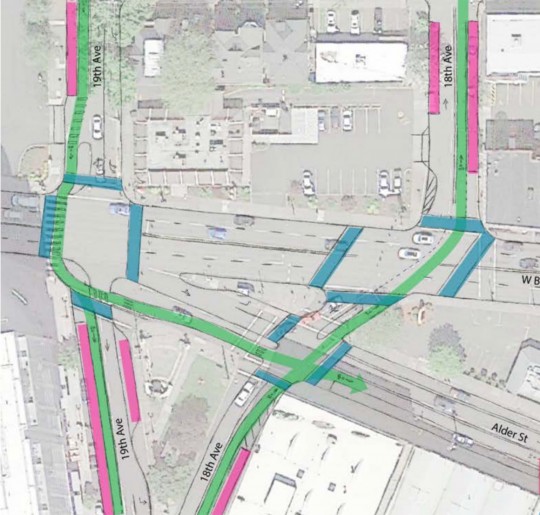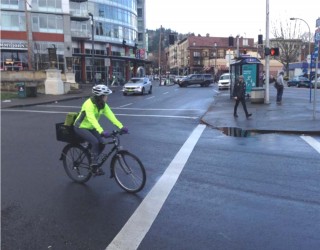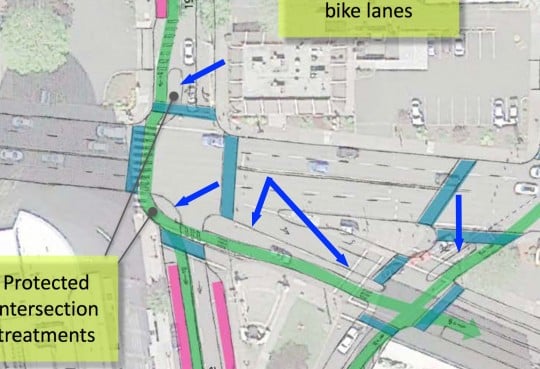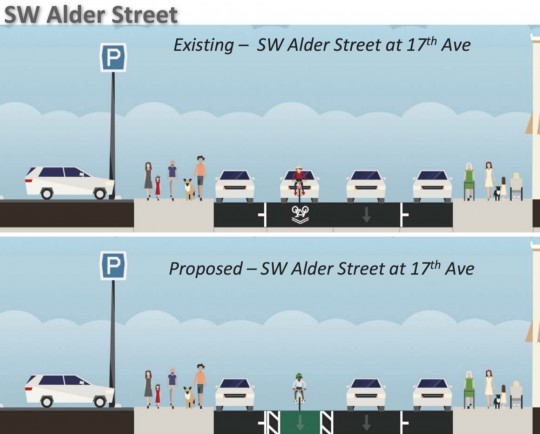
(Image: Kittelson & Associates, Inc.)
Now we know how the City of Portland wants to improve safety along a key section of West Burnside near Providence Park and includes some exciting possibilities: our first protected intersection and a redesign of two other streets where lanes would be changed from a mixed vehicle lane to a bicycling-only lane.
On February 4th we shared the first news about the Portland Bureau of Transportation’s West Burnside Multimodal Study project after being tipped off by a resident who learned about it at a neighborhood meeting. At that time PBOT hadn’t released any details about the project publicly. Now they’ve shared a presentation about the project created by planning consultants Kittelson & Associates, Inc.
The project centers around a host of changes to Burnside at 18th and 19th as well as SW Alder — a cluster of streets that poses safety problems due to hilly contours and diagonal crossings. Improvements here would make all users safer; but PBOT says their focus for this project is to improve conditions for biking and walking.
Advertisement
While PBOT envisions 18th and 19th as future “major city bikeways,” they’re currently listed as caution areas on city bike maps. The current cross-section of 18th and 19th is two vehicle lanes that include sharrow markings and two parking lanes. The City’s proposal would convert one of those vehicle lanes into a bicycling-only lane. The new lane would be seven-feet wide with additional 2-3 foot buffer zone. Here’s how it looks in Kittelson’s presentation:
To get people on bikes and foot safely across Burnside, PBOT is considering what would be Portland’s first protected intersection. Protected intersections were conceived by Portland-based planner Nick Falbo and are already on the ground in several cities. Last week we shared six locations where Mr. Falbo said they could work in Portland — and Burnside and 19th was one of them. Here’s how the city’s proposed design looks (Note, we’ve added blue arrows to show new concrete median islands that would “protect” bicycle riders through the intersections):
The final significant change to this area would be to Alder, where PBOT wants to create a bike-only lane from SW 19th to 13th. Here’s a look at the cross-section comparisons:
PBOT is also showing two future designs for Alder. One with a contraflow bike lane and the other with a two-way bike lane physically protected from auto traffic on the north side of the street:
We’ll keep you updated on any developments with this project.
For now, if you have feedback or input, contact PBOT project manager Dan Layden at dan.layden@portlandoregon.gov and visit the project website.
— Jonathan Maus, (503) 706-8804 – jonathan@bikeportland.org
BikePortland can’t survive without paid subscribers. Please sign up today.












Thanks for reading.
BikePortland has served this community with independent community journalism since 2005. We rely on subscriptions from readers like you to survive. Your financial support is vital in keeping this valuable resource alive and well.
Please subscribe today to strengthen and expand our work.
This looks very promising. A few suggestions: instead of the bike-only buffered lane on Alder, why not make it curb-side and fully protected? Two-way cycle tracks are frowned upon, given that they add additional conflicts, so a one-way cycleway with a contraflow lane is preferable. Additionally, Alder between 18th and 19th should be filled in completely, removing the travel lane and retaining the cycle lane. This removes that odd floating triangle as well. There should also definitely be a bike-specifc traffic signal. Everything else about this proposal looks great!
That would not allow future bus service on Alder…
Is bus service needed on Alder?
If the Morrison Bridge is ever fixed, moving the eastbound 15 from Salmon to Alder would save time for riders while eliminating the ridiculous existing five (yes, FIVE!) -block couplet through downtown.
eastbound bus on Burnside could get on Alder at 17th or 15th
True, but it would require more turns and take more time.
Why? Because TriMet doesn’t believe in bus islands? TriMet needs to—in the words of a local ODOT official—”grow up” about bus islands. We have to switch bike lanes and parking lanes now, so we don’t have to do it later.
I was gonna write something… but I realized I’d basically write the same thing Adam did. So just read his comment. 🙂
I agree with Adam’s point re: filling in Alder. Other than that, though, I think this would be a MAJOR improvement to those two intersections, and to 18th and 19th for as far north and south as those bike lanes are connected/extended.
We’ll never see families and the 8-80 set if we put bike lanes right next to opening driver doors and speeding traffic. PLEASE PLEASE PLEASE can we protect people riding bikes by putting lanes curbside, on the inside of car parking.
Curbside is great, but parking between the bike lane and traffic is not the best. It does reduce visibility of bikes and parking isn’t needed on both sides of the streets. It would be better to remove a handful of parking spaces entirely, and add some more pedestrian and bike space instead (or bus lanes on streets shared with transit).
In every implementation of bike lanes on the curb side of parked cars that I have ever seen, the bike lane is so narrow that it is almost fully in the door zone. Add in the fact that most of the crowing of a street is on the far outside and the lack of ability to keep that area clean, and you have a disaster.
I appreciate that you want “something” different, but what you want makes things worse.
It sounds to me as if you’ve had some bad experiences, I certainly have, too. I’m not recommending replicating a narrow/sight-limiting design — but that doesn’t mean that trying something better than putting bike lanes next to faster, heavier vehicles would definitively make things worse.
I agree with others it’s probably not necessary to have parking on both sides of every street, but until we get over that hangup, it seems to me that something like this kind of parked-car-protected-lane https://goo.gl/maps/5PQdWf8wy8u is possible in this location. Very common in Denmark on arterial streets, and it works.
That cycle track is separated from traffic by a wide planted raised curb.
The stretch depicted above also has no major intersections. When the cycletrack reaches a major intersection this happens:
https://www.google.com/maps/@55.7085879,12.577499,3a,75y,30.01h,68.6t/data=!3m6!1e1!3m4!1sPLVZkyLobqQPaPf1PfxV-g!2e0!7i13312!8i6656
No matter what you call it, that’s what always happens at some point… you get run over by the car merging or turning right over the top of you.
Look, I understand that most people are most worried about being run over from behind, and feel safer with lanes of various description. I guess I’m not clear on whether the real goal is to feel safer or to be safer.
I would rather be run over from behind than hooked at a turn, and want to ride accordingly. When portland can stop turning every single project into a testbed, and start building things that protect bikes at intersections, I’m on board.
My reality, is that as long as we start every conversation with the assumptions that a) we must have on-street parking and b) motorists receive no real penalty for running over people with their vehicle, this is mostly pointless.
Heartily agree with both Adam H and Kari. It should really be standard practice to put bike lanes next to the sidewalk, and daylight the intersection so the sightlines are clear. Otherwise, this looks like a really great proposal!
“Protected” or not, through bikes should not be placed to the right of right-turning motor vehicles. In other words, there will still be a high right-hook hazard at a lot of these locations.
Not if proper signaling is installed, which gives people cycling a green while restricting right turn movements for drivers. Additionally, since the protection island places the person cycling further forward than the driver, sight lines are improved and right-hook potential is decreased. Check out this video for a better description on how this works.
Cycle-specific signals will only mean an endless wait for all the motorists to go first before you can cross on your bike. It would be better to make turning right illegal at these locations.
Guess you mean, right on red.
No, right on green.
How it’s done on Hornby Street in Vancouver, BC is that the signal phase for right turning cars is before the signal phase for straight ahead going bikes. It works well most of the time.
Really? So now every single block we need twice as many signals?
Yea… that’s not going to happen, especially not downtown, where everything in Portland has to begin.
If waiting for a signal at every block is what it takes to keep me “safe”, I’ll pass.
The plan should close 18th from Morrison to Burnside and close the Alder slip lane from Burnside to 18th. That would make a nice contiguous public space for the Firemen’s Memorial and get rid of a bunch of truly horrible traffic movements. The pedestrian movements on the proposed plan are ridiculous! This plan does begin to go far enough.
there are better city plans already out there: https://www.portlandoregon.gov/bps/article/502516
I would like to see some level-of-service analysis of bike traffic. I don’t see any bike lanes on that plan you linked to.
Cool proposal bro. Question: Is PBOT’s “updated” plan with bike lanes eliminated every other block (for safety!) and a suggestion to route bikes to Everett instead (it’s not that far, the map is misleading!) already complete, or does that only come out a few months before construction is about to begin?
I really do not understand the love for parking-protected lanes. They are notorious for increasing risk by obscuring sightlines at intersections and are discouraged in Denmark and the Netherlands (except for roads with few intersections). I support conventional protected facilities with a proven track record of comfort and safety and not cheap compromises like parking-protected and bidirectional lanes.
Soren, can you have conventional (door-side/door-zone) lanes that are also protected if car parking is provided on the other side of the lane? Don’t people driving need to get through the bike lane to get to the parking? Perhaps access could be at the beginning of the block, but that seems… challenging for many people who drive, and sharing the bike lane space while the person driving gets to their parking space seems uncomfortable for those biking.
I get the danger at intersections. I just wonder if maybe the comfort level of (good) parking-protected bike lanes is worth the danger.
The better solution is to keep the parked cars away from the bike lane entirely! Parking isn’t needed on BOTH sides of every single street. Most good bike lane installations in the Netherlands and Denmark do not have any parked cars next to the bike facility, on either side.
The better solution is to put all the cars in one place, off of the street.
we won’t overcome the parking 3rd rail if we don’t ask for what we really want. i would love to see raised bed or curb-protected bike lanes on 18th and 19th.
I’m really starting to come around to the idea that parking is THE issue. Fixing parking (and by fixing I mean removing it and making it more difficult to find) will free up street space that can be used for bikes and pedestrians. It will discourage driving. It will make transit run better because of lower car volumes. And it will encourage better (more frequent!) transit because fewer people will be driving, and some of those people will switch to Trimet.
Combine this with a residential parking program, meters on ALL commercial streets (and residential streets as needed), and congestion pricing via tolls on the I-5 and I-205 bridges, and we would make getting around Portland better for everyone: pedestrians, cyclists, transit riders, and, yes, drivers.
Wow. Someone actually said it. Congrats.
I want to clarify my position. I support protected intersections. I also prefer protection over no protection. However, I strongly believe that sight-lines near intersections need to provide more than a couple of seconds of reaction time for people driving heavy machinery. I’d be “OK” with a car-protected lane that is designed so that people driving have time to respond to a person cycling into the intersection on a green light at 16-17 mph. This would require at least 100 feet with no parking near an intersection (a motor vehicle traveling 20 mph on a green covers ~60 feet in 2 seconds).
I should also note that parking-protected lanes are not considered particularly comfortable by survey respondents:
http://www.peopleforbikes.org/blog/entry/three-charts-for-protected-bike-lane-designers-to-remember-in-2015
Are we really getting our best bang for the buck with the above designs. I think not.
A continuing theory, with some legitimate hope to is, is that there’s lots of people that would be riding bikes if they didn’t have to ride in or directly alongside motor vehicle traffic. These so called protected bike lane treatments are for them.
Quick, traffic seasoned people likely will want to continue riding the main lanes with motor vehicle traffic. Relying only on that status quo may not change the numbers much. Particularly with the city giving bike share a shot, protected bike lane and intersection treatments may help bike share in Portland, succeed.
If the question about what infrastructure to build, was just for the kind of riding I do, I’d say forget all this complicated mash-up. I don’t like green bike lanes that seem to get ugly looking fast, or concrete islands taking up space between bike lanes and main lanes of the road. Some people seem to think that kind of thing is wonderful though. May as well let them try it out and see how they like it.
Hey, I almost got right hooked on NE Multnomah at the eastern Lloyd Center entrance this Saturday, and the buffer didn’t make one bit of difference, even though sight lines are plenty good there. Why? Because the motorist simply wasn’t paying attention and/or didn’t expect through bikes to his right.
Any design that places through bikes to the right of right-turning traffic is going to continue to be a hazard, regardless of buffers or separation, unless right turns are prohibited or complicated new signals are installed that will be both expensive and result in much longer wait times.
I know this a bike blog, but check out the miserable pedestrian experience this plan proposes. The Blue polygons represents crosswalks. Now imagine you are walking west on the south side of Burnside. This is NOT ok.
Have you checked out the miserable pedestrian experience that exists today? If the new crossings shown above are built it would be a big upgrade.
This proposal is only invcrementally better than existing conditions. Close 18th and close Alder from Burnside to 18th and fix the walking experience.
Road diet Bunside with a center left turn lane and bike lanes from the Park Blocks to 24th
I really dislike these creations. At the junctions, one must find a way to prevent right-hooks since the bike lanes are kept to the right of turning motorists. No turn on red solves the red-light portion, as long as there is enforcement. If one chooses to do a bike-only phase, that still requires extensive enforcement and adds signal phases (everyone waits).
Then, we have the left-turning cyclist issue. Either there is a bikes-only everywhere phase, which doubles the signal wait time for everyone, or cyclists have to wait through two signal cycles to make a left turn. Welcome to second-class status. This also costs cyclists their main urban advantage: speed through the congested grid.
Overall, I see this as a step backwards. I know it’s what the bikeportland crowd likes to crow about, but having lived in an American setting where bikes dominate without such sub-standard builds, I’m unimpressed in the extreme. They create more problems than they solve.
How/where would bikes get on the other side of right-turning auto traffic or make the left onto Alder from 19th without turning around an island? Shared left turn space on 19th?
I’ll agree the forced two-stage left is a 2nd-class treatment. I don’t think two simultaneous greens per cycle would be a problem (“don’t like waiting, ride a bike” sounds fair.) But gas is cheap right now, so there will be entitled complaining.
And yes, without traffic enforcement, right-of-way goes by tonnage.
The overall idea looks ok, but history suggests that the bike lanes will be too narrow, the auto lanes too wide, and I can already see that the corner radii are way too large. The NE corner at 19th and Burnside doesn’t even need a radius.
I’ve ridden South on 19th and made a left turn down SW Alder more times than anybody you know (one of my best customers is in NW). A right-hand bike lane to set up a left turn onto Alder is a crazy waste of resources (paint, concrete, signals, time waiting for signals to cycle, time waiting for construction to be completed, etc.)
I’m getting a little tired of complex ‘improvements’ that make my life worse. This intersection is not sketchy, I’d call it maybe a 2 out of 10, while NE Broadway is more like a 5, maybe a 6 in spots.
Crossing Burnside Northbound on 18th is a little dicey because the signal timing leaves you sitting at the stopline on your invisible bike in front of car traffic making a steepish downhill corner that’s a bit blind, to get to their tasty right on red. Signal timing, a bike box, or a bike lane could help that. It doesn’t need to be torn up.
If you want to slap a global fix on the whole thing, just do a (20 second?) ped/bike free-for-all, a real Barnes Dance, not like that totally confusing cock-up at 11th and NW Couch. If you don’t think too good, don’t think too much.
We’re entering an interesting time in Portland bikeway development, where changes in design approach intended to make bicycling work for all portlanders may conflict with the desires of the few bicyclists riding today.
This conflict happened in the 90’s with the introduction of regular bike lanes (“real” bicyclists hated those), and it will happen again with the introduction of protected bike lanes and protected intersections.
Your fallacy / fatal flaw is the assumption that these ‘new’ designs will ‘work for all cyclists’.
None of these designs do a single thing to reduce cyclists’ risk from right-hooks. You are trading actual safety for the perception of safety, to the great detriment of every new cyclist who will be injured testing these unproven and flawed ‘new’ designs.
Right hooks are rare in the netherlands. Protected intersections have a proven track record.
“Right hooks are rare in the Netherlands”
Well, I hear so are non-signalized intersections and rights on red…and untrained drivers, and cyclists being deemed at fault for collisions, and hit-and-run, and cases where drivers get away with negligible consequences for killing pedestrians or cyclists… all that stuff is rare in the Netherlands, it seems.
Third “E” of complete infrastructure, “Enforcement”. If the first two are done right very little enforcement is needed to keep cyclists safe.
Rode this route for 4.5 years and I totally agree with everything you said. South to Alder from 19th is not at all stressful on a bike, you just take the middle of the left lane on 19th and have the downhill speed to keep you with traffic. The only problem heading north on 18th, the only real problem is people speeding up to blow the red on alder right when you get a green (always take a pause), or possibly a right hook before entering the intersection on burnside, especially if you’re coming off a stop. A leading bike signal would help there without adding so much infrastructure. I think there are bigger hot spots to worry about.
Make 19th south of Burnside two-way with one motorist lane and one bike lane in each direction. Close 18th south of Burnside. Close the Alder slip lane so pedestrians can have a continuous sidewalk on the south side of Burnside. Burnside from Park to 24th Pl could get a road diet and have one motorist lane in each direction, one bike lane in each direction and a center turn lane.
I really hope they do not build this proposed plan. It does enough for pedestrian and bike riders and locks in a bunch of truly dangerous infrastructure for another 30 years.
This has been mentioned before, but if you put a two-way bike lane or a contra-flow lane into Portland’s (mostly) one-way grid, the bikes going against the flow will average 3 mph, about 1 minute per block. This assumes no change in the existing signals, of course. Even if you solve this ‘red wave’ problem, a rider will be encountering many turning drivers who don’t expect an oncoming bike. This stuff makes me want to drag out the old VC icon.
People walk downtown at 4 mph on streets where vehicles are going the other way. So you’d go a bit faster than 3 mph. And a lot of people want to bike in that direction, even if it isn’t fast. Now they do it on the sidewalk. Better to give them a place in the street where they aren’t in conflict with pedestrians. If the city installs protected bike lanes and they’re wide enough for two cyclists to pass each other they should be signed as bidirectional.
If they’re going the same speed because of the lights, it’s hard to see how they are in conflict with pedestrians. Then again, drivers speed around me cruising with the green-wave at 13mph just to stop at the red light and get in the way, so probably those are the same people biking fast upstream on the sidewalk and later going for a jog in the bike lane? (It’s actually all one guy, who is on contract with the hyundai dealer.)
Personally, if I were on southbound 19th and wanted to turn onto eastbound Alder, I would prefer to ride in the traffic lane and simply turn, instead of riding in the bike lane and then have to cross the flow of traffic continuing south on 19th. However, I can see that some cyclists will prefer to complete the entire maneuver without leaving the bike lanes and mixing in with the car traffic.
All in all, I think we should test out this protected intersection design at a few places, and this looks like a good place to try it.
The proposed treatment of Alder looks very nice. It may be appropriate to have raised curb island sections at the start and end of the bike lane on each block, to discourage cars from driving in the bike lane. This would be similar to N Williams where, after the initial adjustment period, drivers are generally not confusing the bike lane and buffer for traffic lanes. These raised curb islands would also discourage right hooks and protect pedestrians.
As for the “future” options for Adler, I think bi-directional bike lanes work okay if they are as wide as a full traffic lane, with a center stripe separating directions. Kind of like SW Moody.
Moody is not a bike lane, it is a fully-separated bike path.
It is bi-directional, and the bike part is adequately wide, so cyclists don’t crash into each other. Yes, the bidirectional part of the SW Moody path doesn’t have the issue of crossing intersections.
No ‘testing’. I’m tired of all the experimental bike infra BS PBOT has cooked up, and more is NOT better…
Please, oh please—if we must have segregated bike lanes, don’t make them bi-directional if they ever cross a driveway or cross street.